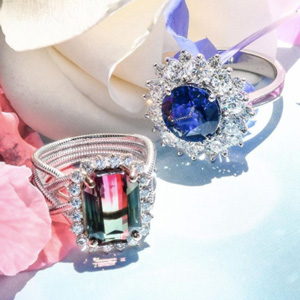
Simon G. Jewelry has been a jewelry store staple for 35 years. The family-owned brand, led by chief executive officer Zaven Ghanimian, is currently in more than 800 retail doors, including well-known independent chains Robbins Brothers, Diamonds Direct, and Smyth Jewelers. And in its long history, the company’s never sold directly to consumers.
But the nationwide store closures brought on by the COVID-19 pandemic have prompted the company to rethink its wholesale-only model—in ways that benefit its hundreds of retail partners.
Simon G. debuted an e-commerce platform on its website Wednesday to sell its fine jewelry directly to consumers online. But there’s a twist: A portion of the profits from every transaction will benefit the retailer located closest to the customer.
“We’ve discussed shifting to direct to consumer in the past and knew what a big step it would be for the brand,” Ghanimian said in a prepared statement. “Our retail partners are the foundation of our business and to make an extreme adjustment would have to positively impact them.”
The brand plans to keep this change in place for the foreseeable future. And its pivot to D2C selling—even if it’s short-lived—is aligned with how the retail jewelry landscape is changing as it’s being forcibly shaped by the stark realities (and widespread fears) surrounding in-person shopping in the coronavirus era.
Jewelry brands all over the country are having to adapt to thrive—and even survive. We recently wrote about the new Essential Jewelry Collective, co-launched by jewelry designer Samantha Jackson, which corrals small brands into an e-commerce portal, and jewelry designer Bibi van der Velden’s efforts to heighten the visibility of her commerce portal, Auverture, which specializes in rarefied fine jewelry brands including her own.
Setting up e-commerce is the obvious answer. But for large B2B brands such as Simon G., debuting an e-commerce portal or an Instagram shop can be a delicate endeavor. Brands that ignore or bypass their wholesale foundations—the partnerships they’ve worked so hard to cultivate—may find that some retailers walk away.
Which is why Simon G. cutting in local retailers on its e-comm transactions—which will bring those partners passive income—is both a sound and savvy move.
“As a B2B business, we reach our customers through our local jewelers who have become valuable, trusted partners that we have long-standing relationships with,” Ghanimian added. “This shift in our business is to benefit them first and foremost.”
Top: Simon G. rings (photo courtesy of Simon G.)
Follow me on Instagram: @emilivesilind
- Subscribe to the JCK News Daily
- Subscribe to the JCK Special Report
- Follow JCK on Instagram: @jckmagazine
- Follow JCK on X: @jckmagazine
- Follow JCK on Facebook: @jckmagazine